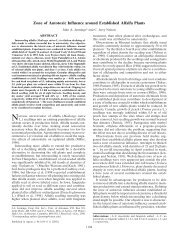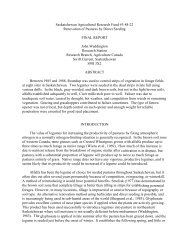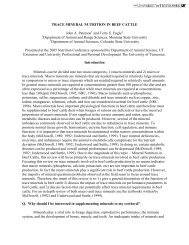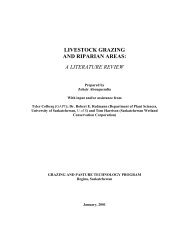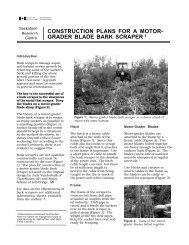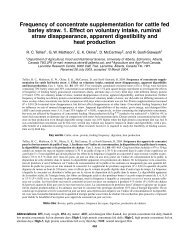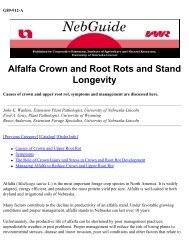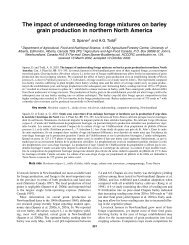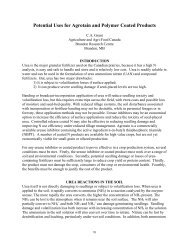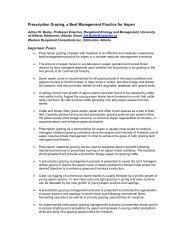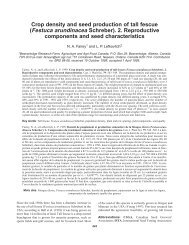Seed Production of Slender Wheatgrass I. Introduction Slender ...
Seed Production of Slender Wheatgrass I. Introduction Slender ...
Seed Production of Slender Wheatgrass I. Introduction Slender ...
Create successful ePaper yourself
Turn your PDF publications into a flip-book with our unique Google optimized e-Paper software.
<strong>Seed</strong> <strong>Production</strong> <strong>of</strong> <strong>Slender</strong> <strong>Wheatgrass</strong>I. <strong>Introduction</strong><strong>Slender</strong> wheatgrass, Elymus trachycaulus (Link) Gould ex Shinners or Agropyrontrachycaulum (Link) Malte, is a native short-lived perennial bunchgrass. It was widely used forseeding in Western Canada and was known as western ryegrass during the early days <strong>of</strong>agriculture. Around 1920, slender wheatgrass along with smooth bromegrass and Grimm alfalfarepresented the “forage triumvirate” for the prairies. With the introduction <strong>of</strong> crested wheatgrassduring the 1930’s, slender wheatgrass was replaced as a major forage because the newlyintroduced grass produced more “horsepower” per acre, had a longer productive life, was moredrought resistant, and was less susceptible to disease and insects.Annual production <strong>of</strong> slender wheatgrass ranged between 25 - 50 tonnes over the pastsix decades. During the mid 1970’s, production rose to 150 tonnes annually for a few years, butthen declined to traditional levels. Pedigreed production has increased to about 500 acresrecently as native species are preferred for reseeding reclamation and conservation areas. Themain varieties multiplied in Canada under pedigreed regulations have been Revenue, Adanac,and recently, AEC Highlander. Average seed yields <strong>of</strong> slender wheatgrass are 200 kg/ac, butyields as high as 300-400 kg/ac have been recorded.II. Field selectionA. AdaptationThe grass is a leafy bunch grass with dense fibrous roots to a depth <strong>of</strong> about 45 cm. Thebunches enlarge by tillering to a diameter <strong>of</strong> about 30 cm. The base <strong>of</strong> the stems has a reddishor purple color. The grass is adapted to a wide range <strong>of</strong> soils, but performs better on sandyloams. The grass is less tolerant <strong>of</strong> drought than crested or western wheatgrass. It requiresmore than 350 mm <strong>of</strong> annual precipitation, but is not tolerant <strong>of</strong> waterlogged soils. The grass ishighly productive for the first few years after seeding before decreasing in a stand. It is lesscompetitive with weeds than other wheatgrasses, but is tolerant <strong>of</strong> shade.The grass has excellent germination and emergence and is well suited to low areasprone to salinity. <strong>Seed</strong> stalks are 60-120 cm tall with an abundance <strong>of</strong> leaves. The seeds arelarger than crested wheatgrass. <strong>Seed</strong> yields are more consistent in regions receiving 350-500mm <strong>of</strong> annual precipitation. Under dry conditions, seed head formation may be inadequate tojustify harvest <strong>of</strong> the seed.B. Freedom from weedsThe field selected for slender wheatgrass seed production must be free <strong>of</strong> noxiousgrassy and broadleaf weeds. A field may be left unattended for several weeks with only minimalweed growth and no appearance <strong>of</strong> quackgrass or Canada thistle only to have these weedsappear later. Noxious weed seeds disqualify the seed for market as pedigreed seed.
Weeds with similar size and shape <strong>of</strong> seeds to slender wheatgrass are extremely difficultto separate at the cleaning plant. Primary noxious weeds which are inseparable are quackgrass,Canada thistle, and perennial sow thistle. Secondary noxious weeds which are difficult toremove from seed lots include wild oats, stickseed (bluebur), and Persian darnel. Downy bromeis a particularly difficult weed to control in seed stands <strong>of</strong> slender wheatgrass. Fields selected forseed production <strong>of</strong> slender wheatgrass must be sown on land free <strong>of</strong> these weeds.Three applications <strong>of</strong> glyphosate over two to three years are required to controlquackgrass. Pre-harvest glyphosate application at 1 liter per acre prior to sowing the grassgreatly improves control <strong>of</strong> quackgrass, Canada thistle, and sow thistle. Quackgrass from theseed bank and dormant rhizomes in the soil will re-infest the field, so several years <strong>of</strong> control areessential to reduce the possibility <strong>of</strong> recontamination. A fallow or partial fallow period prior toseeding controls several flushes <strong>of</strong> annual broadleaf and grassy weeds. Prior to seeding thegrass, weed control is easily achieved with broad spectrum herbicides and cultivation.C. Freedom from herbicide residues<strong>Slender</strong> wheatgrass seedlings are sensitive to injury from soil residues <strong>of</strong> grassyherbicides. The residues <strong>of</strong> trifluralin herbicides (Advance 10G, Rival, Treflan) pose the greatestrisk <strong>of</strong> herbicide injury for new seedings <strong>of</strong> grasses. These herbicides disappear from soil byvolatilization. If these products have been applied at the maximum rate for oilseed or pulse cropproduction, grasses should not be sown for 24 months following a spring application or 30months following a fall application. Fortress may also have some carryover residue if thevolatilization <strong>of</strong> the herbicide is restricted by dry conditions. <strong>Slender</strong> wheatgrass should not besown in a rotation directly following a crop treated with Fortress.Other products which have injured grass seedlings include Ally, Assert, Atrazine, Banvel,Glean, Princep/Simazine, Pursuit and Sencor. Many <strong>of</strong> the herbicides in this listing are onlyproblems if used at high rates in the growing season prior to sowing the grass. Check the latestedition <strong>of</strong> Saskatchewan Agriculture and Food’s Crop Protection Guide for current guidelines.D. Pedigreed RequirementsThere are three classes <strong>of</strong> pedigreed forage seed production in Canada: Breeder,Foundation, and Certified. Foundation seed is grown from Breeder seed and Certified seed isgrown from Foundation seed. The seed must meet standards for germination, genetic purity,freedom from disease, and absence <strong>of</strong> the seed <strong>of</strong> weeds and other crops. The Canada <strong>Seed</strong>Act specifies that seed must be pedigreed to be sold as a named variety.The regulations for pedigreed status <strong>of</strong> seed are outlined in the Canadian <strong>Seed</strong> GrowerAssociation Circular 6. In the year <strong>of</strong> seeding, the grower must notify the Canadian <strong>Seed</strong>Growers' Association <strong>of</strong> the pedigree <strong>of</strong> the seed planted and the area and previous croppinghistory <strong>of</strong> the production field. The field should be free <strong>of</strong> volunteer slender wheatgrass prior toseeding. Manure or other potentially weed contaminating material should not be applied to the
field prior to seeding or during the productive life <strong>of</strong> the stand. Table 1 summarizes theregulations on the minimum cropping interval.Table 1: Intervening crop seasons before re-cropping with slender wheatgrass as requiredby CSGA regulationsClass <strong>of</strong> seed sown Class <strong>of</strong> seed harvested Contaminating crop Number <strong>of</strong> intervBreeder Foundation Non-pedigreed or different variety <strong>of</strong> slender wheatgrass 5 seasonsBreeder Foundation Same variety <strong>of</strong> slender wheatgrass 3 seasonsBreeder or Foundation Certified <strong>Slender</strong> wheatgrass 2 seasonsA field sown with Breeder slender wheatgrass seed is eligible for three years <strong>of</strong>Foundation plus two years <strong>of</strong> Certified seed production. A field sown with Foundation slenderwheatgrass seed is eligible for five years <strong>of</strong> Certified seed production. Two inspections arerequired annually for each pedigreed seed lot - a field inspection and a seed analysis. Theproduction field must be inspected after the crop has headed, but prior to swathing or harvestingfor each year that pedigreed seed will be harvested. The seed lot must also be analyzed forweed and disease contamination and tested for germination. The identification tags from theseed bags must be retained for the life <strong>of</strong> the stand for presentation to the crop inspector.<strong>Slender</strong> wheatgrass is one <strong>of</strong> the few self-pollinated grasses. The isolation requirementdepends on the class <strong>of</strong> seed produced and the size <strong>of</strong> the field as summarized in Table 2.
Table 2: Isolation distances required by CSGA regulationsPedigree <strong>of</strong> <strong>Seed</strong> ProducedField Size (ac) Foundation CertifiedLess than 5 acres 400 m 150 mMore than 5 acres 300 m 50 mIII. Crop establishmentMuch <strong>of</strong> the acreage <strong>of</strong> slender wheatgrass for seed production is sown with certifiedseed. Care is required to purchase stock seed which is free <strong>of</strong> downy brome contamination.Downy brome is a potentially serious weed which occasionally appears in seed from Americansources. Downy brome has a reddish head colour and if nested in new stands <strong>of</strong> slenderwheatgrass should be eliminated immediately. Marketability <strong>of</strong> slender wheatgrass seed free <strong>of</strong>downy brome is much greater and commands a premium in the marketplace.The main objective for the establishment year is to produce a healthy stand <strong>of</strong> seedlingswhich are vigorously tillering. <strong>Slender</strong> wheatgrass may be sown with any conventional plantingequipment if shallow seeding and adequate packing are achieved. Sowing no deeper than oneinch with firm packing helps achieve maximum germination and rapid emergence <strong>of</strong> seedlings.As the seeding depth increases, the time required for the seedling to emerge increases and thepercentage <strong>of</strong> seedlings that emerge decreases (Figure 1). Although air seeder cultivators andhoe drills have successfully established slender wheatgrass, disc drills are the most commonseeding implement. Zero-till seeding provides the firm moist seedbed into which the seed can beplanted shallowly without difficulty. When zero-till seeding, ensure that there are options forcontrolling volunteer crop seedlings.A firm seedbed is the most important requirement for shallow, even placement <strong>of</strong> grassseed. Packing after the last tillage operation helps firm the soil. Pulse crop rollers are anexcellent way to level and firm the soil prior to seeding. A rainfall following the final tillageoperation will also firm and moisten the seedbed.Simple equipment modifications relieve many potential difficulties and minimize the risk<strong>of</strong> poor establishment. A packing wheel ahead <strong>of</strong> the disc opener levels the seeding surface andpacks the soil. Depth control bands on discs maintain a shallow sowing depth and preventoverdeep seed placement. Packer wheels following directly behind the seeding disc providegood seed to soil contact.The slender wheatgrass seed crop may be sown any time between early May and midJuly with little difference in seed yield for the first seed harvest. With longer delays in seeding,
the first crop seed yield may be reduced, but subsequent crops <strong>of</strong>ten compensate for the smallerinitial seed crop. Late fall and dormant seedings also work well for establishment <strong>of</strong> slenderwheatgrass, but no seed will be produced until the second fall after seeding.Planting into a “stale seedbed” is an effective method for establishing slenderwheatgrass. The land is tilled, packed, leveled, and left to settle for two to three weeks. Dew andone or two rains during the interim period firm the seedbed. A burn-<strong>of</strong>f rate <strong>of</strong> glyphosate isapplied just prior to or immediately after seeding with a disc press drill. The herbicide applicationeffectively controls weed seedlings and minimal disturbance prevents new weed growth. Theseedbed remains firm and moist to the soil surface which is an excellent environment forgermination and growth <strong>of</strong> new grass seedlings.Applying this technique for planting into standing cereal stubble is an equally effectivevariation. The standing stubble provides protection from the wind, an ideal microclimate forestablishment <strong>of</strong> the grass seedling. The anchored stubble also reduces the risk <strong>of</strong> erosion fromheavy summer rains. Effective spreading <strong>of</strong> chaff and straw prior to seeding are essential forsuccessful use <strong>of</strong> this technique.<strong>Slender</strong> wheatgrass flows much better than many <strong>of</strong> the chaffy grasses, but it will bridgein seed cups if the seed sample is chaffy. Bridging causes inconsistent plant stands and missingseed rows. Agitators in the seed box prevent bridging and improve flow <strong>of</strong> the light chaffy seed tothe seed cups. If agitators are not available for your seed tank to disturb the grass seed, fillingthe seedbox only half full and getting extra help to mix the seed in the seedbox while planting willwork. Polymer seed coatings improve the seed flow in the drill and protect the user fromexposure to any seed treatments which may be added to control disease organisms. Carrierssuch as phosphate fertilizer (11-52-0) up to 15 lb P205/ac, non-viable grain, or horticulturalvermiculite clay may be mixed with the grass seed to help prevent bridging. <strong>Seed</strong> may also bemixed with phosphate fertilizer and “drilled” through the fertilizer attachment. Fertilizer will absorbhygroscopic moisture from the air over time and increase the moisture content <strong>of</strong> the seed. Theincrease in moisture content <strong>of</strong> the seed will decrease its viability. <strong>Seed</strong> mixed with fertilizer canbe stored up to 3-4 weeks without injuring the seed germination as long as the mixture is storedunder dry conditions.B. Row spacingWide row planting <strong>of</strong> slender wheatgrass has several advantages. Planting in widerspacedrows reduces the seed requirements, lowering input costs. As the stand ages, the plantscan expand into the vacant area between the rows and maintain a higher seed yield potential.Although inter-row cultivation may stimulate new weed growth, tillage is easily performed with arow crop cultivator or gang rototiller. Weeds for roguing are easier to spot when the grass issown in rows. Row production without irrigation also reduces the risk <strong>of</strong> seed yields reduced bydrought. Because slender wheatgrass is a bunch grass, it should be sown with a row spacing <strong>of</strong>
12 to 18 inches. The seed yield <strong>of</strong> the first year or two <strong>of</strong> a stand must be maximized because <strong>of</strong>the short-lived nature <strong>of</strong> the grass. The wider row spacings are recommended for lighter texturedsoils.The wide row spacings are easily accomplished with conventional equipment by placingtape over the unwanted seed cups in the seed box. Depending <strong>of</strong> the equipment, raisingunwanted discs or seed boots may also be possible. Some growers release the spring pressureon hoe drills so that the shoe just rides along the surface <strong>of</strong> the soil. With airseeders, blocking <strong>of</strong>outlets in discharge heads needs to be symmetrical tomaintain uniform airflow. A wide range <strong>of</strong> modifications are easily accomplished depending onthe type <strong>of</strong> equipment owned.The seeding objective is to sow enough seed to achieve a satisfactory stand without toomuch inter-plant competition. <strong>Seed</strong>lings which are vigorously tillering will produce a higher seedyield. Because the weather is an important factor in the establishment <strong>of</strong> a seeding, the safeapproach is to seed at a higher rate than is suitable for ideal conditions. It is wise forinexperienced growers to plan for loss <strong>of</strong> up to 80% <strong>of</strong> the seedlings. The seeder should becalibrated to sow 12 - 20 seeds per foot <strong>of</strong> seed row. When another material is mixed with theseed to eliminate bridging, the seeds per foot method <strong>of</strong> drill calibration eliminates guesswork.Using the seeds per foot method, the same rate <strong>of</strong> 20 seeds per foot <strong>of</strong> seed row is appropriate.<strong>Slender</strong> wheatgrass, on average, contains 159,000 seeds per pound. For a row spacing <strong>of</strong> 1 footand a seeding rate <strong>of</strong> 20 seeds/ft, one acre (43,560 ft2) contains 43,560 feet <strong>of</strong> seed row andrequires 871,200 seeds or 5.5 lb seed/ac. The drill is easily calibrated by seeding over a sheet <strong>of</strong>plywood or a pad <strong>of</strong> concrete and counting the seeds sown over a measured distance.C. FertilityThe soil fertility <strong>of</strong> the seed field should be determined by soil analysis prior to sowing.When sowing slender wheatgrass for seed production on fallow or partial fallow, nitrogen is likelyadequate to carry the grass until the first fall after seeding. When stubble fields are sown prior toJune 1, 20-40 lb N/ac should be applied to dryland fields and 40-60 lb N/ac to irrigated fields.- Afall application <strong>of</strong> 30 lb N/ac to establishing seedling fields will promote maximum seedproduction in the first seed crop.Phosphorus and potassium deficiency are best corrected prior to establishment <strong>of</strong> thecrop. Phosphorus enhances the growth rate and vigour <strong>of</strong> the seedlings. Yield responses <strong>of</strong>grasses to applications <strong>of</strong> phosphorus and potassium are marginal once the stand is established.For fields testing less than 15 lb P/ac, phosphate fertilizer should be applied at 50-75 lb P205/ac.Likewise, for fields testing less than 200 lb K/ac, 100 lb K20/ac. should be applied prior to sowingthe grass. Sulphur levels will be adequate if the field has been fertilized with enough sulphur foroptimum canola production within the last two years. <strong>Slender</strong> wheatgrass responses to
Clipping or mowing is another effective strategy for controlling annual weeds. The weedsshould be mowed as required to prevent them from setting seed. After the grass crop becomesestablished, fewer weeds will germinate during seed production years.Field roguing is a requirement for production <strong>of</strong> quality grass seed for the Canadianmarket. Primary noxious weeds such as quackgrass, Canada thistle, cleavers, and wild mustardmust be removed from the stand. Selective herbicide control <strong>of</strong> quackgrass in slenderwheatgrass is not available. Quackgrass can only be removed from the field after sowing by spotspraying glyphosate with a backpack sprayer or hand roguing. Unthreshed wild mustard seedslodge in the beak <strong>of</strong> the seed pod and this broken remnant <strong>of</strong> the pod cannot be removedbecause <strong>of</strong> its similar size to slender wheatgrass seed. Secondary noxious weeds such as wildoats, Persian darnel, scentless chamomile, shepherd's purse, stickseed (bluebur), and stinkweedare tolerated in small numbers, i.e. 4-10 in 25 g.; however, some market standards are morestringent than Canada <strong>Seed</strong> Act standards. Certain seeds are very difficult to separate and theseweeds must be eradicated in the field.The seed grower must be vigilant to prevent re-introduction <strong>of</strong> weeds to the field. Crownsand rhizomes from previous perennial grass crops in the rotation will re-establish in seedlingstands. Weed or crop seed in irrigation water or on equipment are one source <strong>of</strong> contaminationwhen deposited within the field.B. Disease and insect monitoringDisease and insect problems in slender wheatgrass seed fields can lead to significantseed yield losses. The more common disease problems is head smut, and ergot. Head smutcan be a major fungal disease in slender wheatgrass seed crops. Spores from inflected seedheads are dispersed to new seeds during harvesting. Smut is characterized by a seed headwhich has been totally destroyed by the fungus. The seeds are replace by a mass <strong>of</strong> blackspores. The disease is best controlled by using smut-free seed and properly applying a systemicseed treatment registered for control <strong>of</strong> loose smut.Ergot is indicated by collection <strong>of</strong> a sticky honeydew on the surface <strong>of</strong> infected floretsduring flowering or large black structures that replace individual seeds in the mature head. Ergotis controlled by sanitation and by use <strong>of</strong> ergot-free seed. <strong>Seed</strong> cleaning is able to remove most<strong>of</strong> the ergot bodies from the seed lot. Storing the seed for a full year prior to using it reduces theviability <strong>of</strong> the ergot bodies. Field burning will also reduce the survival <strong>of</strong> ergot bodies. Sanitation<strong>of</strong> field edges or mowing will prevent infection from adjacent field edges.Silvertop has been reported in slender wheatgrass. Silvertop reduces seed yield byprematurely halting development <strong>of</strong> the seed head. The head emerges from the stem, but turnswhite when the supply <strong>of</strong> water and nutrients is cut <strong>of</strong>f. Insect puncturing or feeding and localfungal infection above the topmost node are <strong>of</strong>ten associated with silvertop seed heads. The end
esult is a conspicuous white seed head with no seed. The white seed head is easily removedfrom the stem by tugging on the white headC. Irrigation management<strong>Slender</strong> wheatgrass responds very strongly to good moisture conditions (Figure 2).Irrigation will increase seed yields if moisture stress occurs during the rapid spring growth,pollination or seed development stages. Frequent light sprinkler irrigation during establishmentprovide adequate moisture for germination and establishment. Flood irrigation is difficult in newlyseeded fields because <strong>of</strong> the risk <strong>of</strong> erosion and crusting. Once the crop is established, irrigationduring periods <strong>of</strong> high evapo--transpiration will promote vigourous growth. Soil moisture shouldbe maintained above 50% <strong>of</strong> field capacity. Adequate soil moisture during the period <strong>of</strong> rapidgrowth in spring and during the boot stage are the most critical periods for high seed yields.Water penetration to a depth <strong>of</strong> 60 - 120 cm indicates adequate soil moisture. The soil pr<strong>of</strong>ileshould be at field capacity just prior to pollination. Irrigation during flowering may reduce seedset, but a final irrigation just after pollination may be required to fill the developing seeds. <strong>Seed</strong>production <strong>of</strong> slender wheatgrass on dryland is also feasible, but seed yields are more variable.V. HarvestGrasses need about 30 days after flowering for the seeds to develop. Hot, dry weathershortens the ripening period while cool, moist conditions delay seed maturity. Grasses grownunder irrigation or moister conditions have a higher ash content which increases the likelihood <strong>of</strong>shattering. Ripening begins at the top <strong>of</strong> the seed head and proceeds down the stem. <strong>Seed</strong>s atthe top <strong>of</strong> the head may begin to shatter while those at the bottom are only starting to fill seed.Frequent inspection <strong>of</strong> the seed field is important to determine the best time to harvest. <strong>Slender</strong>wheatgrass is usually ready to swath in mid August. The crop is ready to swath at the harddough stage which corresponds to a seed head moisture content between 40-45%. At this stage<strong>of</strong> maturity, firm thumbnail pressure is needed to imprint the seed. The seed heads will bebrown, but the stems will still be green. Some seed will shatter when the seed head is firmlystruck against the palm <strong>of</strong> the hand.The moisture content <strong>of</strong> the seed head is unreliable when determined with conventionalgrain moisture testers. The seed head should be clipped <strong>of</strong>f just below the lowest seed. Sampleenough seed heads to weigh about 100 g. After determining the wet weight, dry the sample in aconventional oven set at 82oC until the sample reaches a constant weight. The sample may alsobe dried in a microwave oven using relatively short heating intervals <strong>of</strong> about 1 minute. Place a
cup <strong>of</strong> water in the microwave with the sample to prevent it from catching fire at lower moisturecontents. Record the dry weight <strong>of</strong> the sample. The moisture content <strong>of</strong> the sample is calculatedusing the following formula: % moisture = ((wet weight - dry weight) / wet weight) * 100.Conventional equipment is suitable for harvest <strong>of</strong> slender wheatgrass. Some combinesmay separate more seed if equipped with a modification kit to slow the fan speed. Swathing andpicking up the windrow is usually the least risky harvest method, but in years <strong>of</strong> low seed yield,early maturity, or reduced foliage, straight combining may be more appropriate. <strong>Slender</strong>wheatgrass has a moderate shatter risk relative to other grasses and seldom lodges unless veryheavy rates <strong>of</strong> nitrogen have been applied. Swathing early in the morning or in the evening or atnight when the air humidity is higher will reduce shattering losses. If the heads are laid in thecenter <strong>of</strong> the swath instead <strong>of</strong> to the side, some <strong>of</strong> the shattered seeds will be retained within theswath.Under good drying conditions, the crop will be ready to combine in 4-7 days afterswathing. Because <strong>of</strong> the potential for contamination and the value <strong>of</strong> grass seed, thoroughlyclean the combine before threshing grass seed. Initial combine settings recommended forslender wheatgrass are a cylinder speed <strong>of</strong> 1000 rpm and a concave clearance <strong>of</strong> 1/16". The fanspeed is generally set between 400-500 rpm with the sliding covers over the exterior fan housingclosed. The combine should be set so that the lemma and palea are retained on the seed.<strong>Seed</strong>s which retain these seed parts have longer viability in conventional storage. The concavesetting should be adjusted to minimize straw breakage so the sieves do not become clogged. Aproperly adjusted concave just breaks up the head into separate seeds. Maintain an even flow <strong>of</strong>material into the combine. <strong>Slender</strong> wheatgrass <strong>of</strong>ten requires a slower forward speed than wheatto improve separation <strong>of</strong> the seed from the chaff and straw. The air flow needs to be highenough to lift the chaff about 10 cm at the front <strong>of</strong> the sieve so that the seed can be separatedfrom the chaff on the sieve. A very clean sample, however, usually indicates that too much seedis being lost. Use a shovel to check seed loss at the back <strong>of</strong> the combine. Watch for plugging <strong>of</strong>the return when the sample is quite chaffy. The seed can be stored safely in storage bins up toone year when the moisture content is 10-12%. Mold growth and insect damage may still occurat this moisture content. The safe moisture content for storage <strong>of</strong> grasses for longer periods is 8-10%.<strong>Slender</strong> wheatgrass is ready for straight combining at the first hint <strong>of</strong> seed shatter. Whenthe seed shatters as the seed head is lightly struck against the palm <strong>of</strong> the hand, seed shatter isimminent and the field should be straight combined immediately. This is usually about 3-5 daysafter the crop was ready for swathing. The risk <strong>of</strong> losing the crop from brisk winds is high. <strong>Seed</strong>that is direct combined needs immediate aeration and drying to maintain seed quality. Somegrass seed growers install an aeration tube directly into their grain truck so that the seed can beaerated without dumping into a storage bin. Running the seed over a sieve to remove much <strong>of</strong>
the green leaves, insects, chaff and short-stemmed straw reduces the risk <strong>of</strong> heating in the directcombined seed. Significant heating which reduces the viability <strong>of</strong> the seed may occur within onlya few hours.<strong>Slender</strong> wheatgrass seed is one <strong>of</strong> the easiest grasses to handle, but, depending on thechaff in the sample, can be challenging. The seed may flow more like silage than like grain,especially if the sample is not dry. Belt conveyors and front-end loaders handle chaffy grassesgently and efficiently. Large diameter augers can effectively transfer the seed if the intakeopening is large enough to avoid bridging. In the grain bin, the seed is sometimes more easilyhandled with a pitchfork than with a shovel.Drying <strong>of</strong> grass seeds must be carefully done to maintain the viability <strong>of</strong> the seed. Whenthe seed has a high moisture content, the temperature <strong>of</strong> the air flow must be lower to preventinjury to seed germination. The resistance <strong>of</strong> the seed to germination injury from hightemperatures increases as the moisture content <strong>of</strong> the seed decreases.VI. Post-harvest managementTwo fall management practices <strong>of</strong> slender wheatgrass which are critical to sustainingseed yield potential are stubble management and nitrogen fertilization.A. Stubble managementThe first step is to windrow the straw behind the combine and bale and remove the strawas soon as possible after threshing. If the stubble was cut quite long and moisture conditions aregood, the stubble should also be windrowed, baled, and removed as soon as possible tostimulate high future seed yields. When the fall is very dry, this stubble could be left until springto trap moisture. Once spring arrives, the long stubble should be burned or clipped and removedbefore regrowth begins in spring. The weather will not cooperate in some years to allow burningin spring before regrowth occurs.B. Nitrogen managementNitrogen increases the seed yield <strong>of</strong> grasses primarily by promoting growth <strong>of</strong> tillers andby stimulating the growth <strong>of</strong> larger seed heads in those tillers which will form seed heads. Tillersmust have grown enough to be induced to form seed heads by the correct daylength andtemperature for each species. The period <strong>of</strong> the year when this physiological change occursdiffers among grass species. The period when tillers are induced to form seed heads and whenthe new seed head starts to grow may occur very close together or may be separated by severalmonths. <strong>Slender</strong> wheatgrass can develop new tillers during the fall if moisture is available. Theresponse to nitrogen <strong>of</strong> slender wheatgrass has been negative in some experiments, especially ifthe field is naturally quite fertile and moisture is limiting (Figure 2). An early September nitrogenapplication <strong>of</strong> 20-25 lb N/ac under these conditions will promote greater tillering and increase thenumber <strong>of</strong> seed-forming tillers. In early October, the application <strong>of</strong> an additional 50-55 lb N/acwill stimulate the growth <strong>of</strong> the young developing seed heads in early spring. If conditions are
dry, all 70-80 lb N/ac can be applied in mid-September or early October. If the weather turns verycold and the nitrogen cannot be applied until spring, all 70 lb N/ac should be applied as soon asspring breaks, preferably prior to the greening <strong>of</strong> the grass. If spring arrives late or the fertilizercannot be applied until May, the rate should be decreased to 30-40 lb N/ac. Established irrigatedfields require a total application <strong>of</strong> 100-125 lb N/ac per year, but this rate needs to be reduced iflodging occurs.The form <strong>of</strong> nitrogen applied to grass seed fields has a major impact on the seed yieldresponse when applied with a broadcast spreader. The best nitrogen source for broadcastapplication is 34-0-0 (ammonium nitrate). This form is highly soluble in water and readily moveswith soil moisture to plant roots for rapid uptake into the plant. Ammonium nitrate is notvulnerable to volatilization and is less prone to adsorption by stubble residues in the field. Liquidnitrogen is another excellent N source especially if dribbled under cloudy cool conditions orapplied by spoke wheel injection. Because grasses efficiently absorb water from the soil, risk <strong>of</strong>leaching or denitrification is minimal. The ammonium nitrogen in urea (46-0-0) or evenammonium sulphate (20-0-0-24) is not only less accessible to the plant but also morevulnerable to loss by volatilization. If the application can be timed just prior to a significantprecipitation event, any N form will be equally effective.VII. Stand removal<strong>Slender</strong> wheatgrass is taken out <strong>of</strong> rotation effectively by glyphosate application. Thecrop should be cut as high as possible during the last harvest season to leave as many greenleaves as possible for absorption <strong>of</strong> glyphosate. Following harvest, glyphosate should be appliedat 1-2 liter/ac on the green growth. The stand can then be broken with tillage with a lower fuelrequirement. Some regrowth <strong>of</strong> the grass is likely during the subsequent growing season. If abroadleaf crop is sown the following spring, several graminicides are available to control regrowth<strong>of</strong> volunteer slender wheatgrass during the growing season.VIII. Additional referencesCanadian <strong>Seed</strong> Grower's Association. 1994. Regulations and procedures for pedigreed seedcrop production. Circular 6-94. Ottawa, Ont.Murrell, D., Curry, P., Kruger, G., and Pearse, G. 1995. <strong>Production</strong> and marketing <strong>of</strong> nativegrass seed. Farmfacts. Sask. Ag. and Food, Regina, SK.Smith, S.R. 1996. Pedigreed forage seed production. Can. <strong>Seed</strong> Growers' Association, Ottawa,Ont.Smith, S.R. and Smith, S. 1997. Native grass seed production manual. Manitoba Forage <strong>Seed</strong>Association, Arborg, MB.



